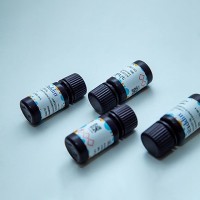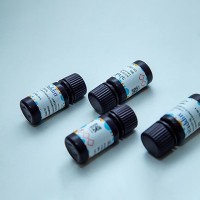Normalizing cDNA Libraries
互联网
- Abstract
- Table of Contents
- Materials
- Figures
- Literature Cited
Abstract
The characterization of rare messages in cDNA libraries is complicated by the substantial variations that exist in the abundance levels of different transcripts in cells and tissues. The equalization (normalization) of cDNA is a helpful approach for decreasing the prevalence of abundant transcripts, thereby facilitating the assessment of rare transcripts. This unit provides a method for duplex?specific nuclease (DSN)?based normalization, which allows for the fast and reliable equalization of cDNA, thereby facilitating the generation of normalized, full?length?enriched cDNA libraries, and enabling efficient RNA analyses. Curr. Protoc. Mol. Biol. 90:5.12.1?5.12.27. © 2010 by John Wiley & Sons, Inc.
Keywords: cDNA normalization; duplex?specific nuclease (DSN); normalized cDNA library
Table of Contents
- Introduction
- Basic Protocol 1: Duplex‐Specific Nuclease (DSN)–Based Normalization of cDNA
- Support Protocol 1: cDNA Synthesis Using the “SMART” Approach
- Support Protocol 2: Duplex‐Specific Nuclease (DSN) Activity Testing
- Support Protocol 3: Size Fractionation and Directional Cloning of Normalized cDNA
- Reagents and Solutions
- Commentary
- Literature Cited
- Figures
- Tables
Materials
Basic Protocol 1: Duplex‐Specific Nuclease (DSN)–Based Normalization of cDNA
Materials
Support Protocol 1: cDNA Synthesis Using the “SMART” Approach
Materials
Support Protocol 2: Duplex‐Specific Nuclease (DSN) Activity Testing
Materials
Support Protocol 3: Size Fractionation and Directional Cloning of Normalized cDNA
Materials
|
Figures
-
Figure 5.12.1 Schematic outline of DSN‐based cDNA normalization. The black and gray lines represent abundant and rare transcripts, respectively. The rectangles represent the adapter sequences and their complements. Within the rectangles, white indicates the common external parts of the adapters, while gray and black correspond to the internal parts that differ between the 3′ and 5′ adapters, respectively, thereby allowing directional cloning of the cDNA library. View Image -
Figure 5.12.2 Agarose gel electropherogram of amplified human cDNA from the control tube. Aliquots (5 µl) were collected after seven (lane 1), nine (lane 2), 11 (lane 3), and 13 (lane 4) PCR cycles, and analyzed on a 1.5% (w/v) agarose/EtBr gel in 1× TAE buffer. Lane M, 1‐kb DNA ladder (Invitrogen; 0.1 µg). The optimal number of cycles determined in this experiment is 10, because the smear appears in the high‐molecular‐weight region of the gel after 11 PCR cycles. View Image -
Figure 5.12.3 Analysis of cDNA normalization results. Aliquots of PCR products from the control and experimental tubes (5 µl each) were loaded on a 1.5% (w/v) agarose/EtBr gel as follows: Lane 1, cDNA from the control tube (10 PCR cycles); lane 2, cDNA from the S1_DSN1/4 tube; lane 3, cDNA from the S1_DSN1/2 tube; lane 4, cDNA from the S1_DSN1 tube (19 PCR cycles each). In this experiment, efficient normalization was achieved in the S1_DSN1/2 tube (lane 3), while normalization was not completed in the S1_DSN1/4 tube (lane 1). In the S1_DSN1 tube (lane 4), the DSN treatment was excessive, resulting in partial cDNA degradation. Lane M shows a 1‐kb DNA ladder (Invitrogen; 0.1 µg). View Image -
Figure 5.12.4 Schematic outline of SMART cDNA synthesis. The rectangles represent the adapter sequences and their complements. View Image -
Figure 5.12.5 Structures of the adapters and primers used for cDNA synthesis and normalization. Common parts of the adapters and primers are indicated by bold; asymmetric Sfi I sites are underlined; rG, riboguanines. View Image -
Figure 5.12.6 Amplified ds cDNA prepared from total RNA obtained from different sources. (A ) Lane 1, mouse liver; lane 2, mouse skeletal muscle; lane 3, mouse brain; lane 4, human leucocytes; lane 5, human lung; lane 6, human skeletal muscle; lane 7, mosquito grub; lane 8, copepod Pontella sp.; lane 9, tomato Lycopersicon esculentum . Lane M shows a 1‐kb DNA ladder (SibEnzyme). In each case, cDNA was prepared from 1 µl of total RNA and amplified in 16 to 20 PCR cycles. (B ) Amplified ds cDNA prepared from total human brain RNA after 15 (lane 1), 18 (lane 2), 21 (lane 3), and 24 (lane 4) PCR cycles. 1 µg of total RNA was used for cDNA synthesis. PCR products (4 µl per lane) were analyzed on a 1.5% agarose/EtBr gel in 1× TAE buffer alongside 0.1 µg of 1 kb DNA ladder. After 21 cycles, a smear is apparent in the high‐molecular‐weight region of the gel, indicating that the reaction is overcycled. Because the plateau was reached after 20 cycles, the optimal cycle number for this experiment is 18. Lane M shows a 1‐kb DNA ladder (SibEnzyme; 0.1 µg). View Image -
Figure 5.12.7 Agarose gel electropherogram of DSN‐treated plasmid DNA. Samples containing 100 ng of plasmid DNA were incubated with or without DSN in 1× DSN master buffer for 10 min at 65°C. Reactions were stopped using DSN stop solution, and digestion products were analyzed on a 1.5% agarose/EtBr gel in 1× TAE buffer. Lane 1, control DNA (DSN‐free incubation); lane 2, DNA incubated with partially inactive DSN enzyme; lane 3, successful digestion of DNA by DSN. Lane M shows a 1‐kb DNA ladder (SibEnzyme; 0.1 µg). View Image -
Figure 5.12.8 Agarose gel electropherogram of non‐normalized (lane 1) and normalized cDNA (lanes 2 to 4) that has been PCR amplified using a too‐long extension step (6 min). No bright bands are visible, and the normalized cDNA appears as a smear starting from the high‐molecular‐weight region of the gel. Lane M shows a 1‐kb DNA ladder. View Image
Videos
Literature Cited
| Literature Cited | |
| Alberts, B., Bray, D., Lewis, J., Raff, M., Roberts, K., and Watson, J.D. 1994. Molecular biology of the cell. 3rd ed. Garland Publishing, New York. | |
| Anisimova, V.E., Rebrikov, D.V., Shagin, D.A., Kozhemyako, V.B., Menzorova, N.I., Staroverov, D.B., Ziganshin, R., Vagner, L.L., Rasskazov, V.A., Lukyanov, S.A., and Shcheglov, A.S. 2008. Isolation, characterization and molecular cloning of duplex‐specific nuclease from the hepatopancreas of the Kamchatka crab. BMC Biochem. 21:14. | |
| Bogdanova, E.A., Shagina, I.A., Mudrik, E., Ivanov, I., Amon, P., Vagner, L.L., Lukyanov, S.A., and Shagin, D.A. 2009. DSN depletion is a simple method to remove selected transcripts from cDNA populations. Mol. Biotechnol. 41:247‐253. | |
| Calvo, E. and Ribeiro, J.M. 2006. A novel secreted endonuclease from Culex quinquefasciatus salivary glands. J. Exp. Biol. 209:2651‐2659. | |
| Carninci, P., Kvam, C., Kitamura, A., Ohsumi, T., Okazaki, Y., Itoh, M., Kamiya, M., Shibata, K., Sasaki, N., Izawa, M., Muramatsu, M., Hayashizaki, Y., and Schneider, C. 1996. High‐efficiency full‐length cDNA cloning by biotinylated CAP trapper. Genomics 37:327‐336. | |
| Carninci, P., Shibata, Y., Hayatsu, N., Sugahara, Y., Shibata, K., Itoh, M., Konno, H., Okazaki, Y., Muramatsu, M., and Hayashizaki, Y. 2000. Normalization and subtraction of cap‐trapper‐selected cDNAs to prepare full‐length cDNA libraries for rapid discovery of new genes. Genome Res. 10:1617‐1630. | |
| Carninci, P., Waki, K., Shiraki, T., Konno, H., Shibata, K., Itoh, M., Aizawa, K., Arakawa, T., Ishii, Y., Sasaki, D., Bono, H., Kondo, S., Sugahara, Y., Saito, R., Osato, N., Fukuda, S., Sato, K., Watahiki, A., Hirozane‐Kishikawa, T., Nakamura, M., Shibata, Y., Yasunishi, A., Kikuchi, N., Yoshiki, A., Kusakabe, M., Gustincich, S., Beisel, K., Pavan, W., Aidinis, V., Nakagawara, A., Held, W. A., Iwata, H., Kono, T., Nakauchi, H., Lyons, P., Wells, C., Hume, D. A., Fagiolini, M., Hensch, T. K., Brinkmeier, M., Camper, S., Hirota, J., Mombaerts, P., Muramatsu, M., Okazaki, Y., Kawai, J., and Hayashizaki, Y. 2003. Targeting a complex transcriptome, the construction of the mouse full‐length cDNA encyclopedia. Genome Res. 13:1273‐1289. | |
| Chenchik, A., Zhu, Y.Y., Diatchenko, L., Li, R., Hil, L.J., and Siebert, P.D. 1998. Gene cloning and analysis by RT‐PCR. In Biotechniques Books (P. Siebert, and J. Larrick, eds.) pp. 305‐319. Eaton Publishing, Natick, Mass. | |
| Chomczynski, P. and Sacchi, N. 1987. Single‐step method of RNA isolation by acid guanidinium thiocyanate‐phenol‐chloroform extraction. Anal. Biochem. 162:156‐159. | |
| Coche, T. and Dewez, M. 1994. Reducing bias in cDNA sequence representation by molecular selection. Nucleic Acids Res. 22:4545‐4546. | |
| Franz, O., Bruchhaus, I., and Roeder, T. 1999. Verification of differential gene transcription using virtual northern blotting. Nucleic Acids Res. 27:e3. | |
| Kunitz, M. 1950. Crystalline desoxyribonuclease; digestion of thymus nucleic. 1 acid; the kinetics of the reaction. J. Gen. Physiol. 33:363‐377. | |
| Liao, T.H. 1974. Bovine pancreatic deoxyribonuclease D. J. Biol. Chem. 249:2354‐2356. | |
| Luk'ianov, K.A., Gurskaia, N.G., Matts, M.V., Khaspekov, G.L., D'iachenko, L.B., Chenchik, A.A., Il'evich‐Stuchkov, S.G., and Luk'ianov, S.A. 1996. A method for obtaining the normalized cDNA libraries based on the effect of suppression of polymerase chain reaction. Bioorg. Khim. 22:686‐690. | |
| Maruyama, K. and Sugano, S. 1994. Oligo‐capping: A simple method to replace the cap structure of eukaryotic mRNAs with oligoribonucleotides. Gene 138:171‐174. | |
| Matz, M.V. 2003. Amplification of representative cDNA pools from microscopic amounts of animal tissue. Methods Mol. Biol. 221:103‐116. | |
| Sambrook, J., Fritsch, E.F., and Maniatis, T. 1989. Molecular Cloning: A Laboratory Manual, 2nd edition. Cold Spring Harbor Laboratory Press, Cold Spring Harbor, N.Y. | |
| Schmidt, W.M. and Mueller, M.W. 1999. CapSelect: A highly sensitive method for 5′ CAP‐dependent enrichment of full‐length cDNA in PCR‐mediated analysis of mRNAs. Nucleic Acids Res. 27:e31. | |
| Shagin, D.A., Rebrikov, D.V., Kozhemyako, V.B., Altshuler, I.M., Shcheglov, A.S., Zhulidov, P.A., Bogdanova, E.A., Staroverov, D.B., Rasskazov, V.A., and Lukyanov, S. 2002 A novel method for SNP detection using a new duplex‐specific nuclease from crab hepatopancreas. Genome Res. 12:1935‐1942. | |
| Soares, M., Bonaldo, M., Jelene, P., Su, L., Lawton, L., and Efstratiadis, A. 1994. Construction and characterization of a normalized cDNA library. Proc. Natl. Acad. Sci. U.S.A. 91:9228‐9232. | |
| Wells, C.A., Ravasi, T., Sultana, R., Yagi, K., Carninci, P., Bono, H., Faulkner, G., Okazaki, Y., Quackenbush, J., Hume, D.A., and Lyons, P.A. 2003. Continued discovery of transcriptional units expressed in cells of the mouse mononuclear phagocyte lineage. Genome Res. 13:1360‐1365. | |
| Young, B.D. and Anderson, M. 1985. Quantitative analysis of solution hybridization. In Nucleic Acids Hybridisation, a Practical Spproach (B.D. Hames and S.J. Higgins, eds.) pp. 47‐71. IRL Press, Washington, D.C. | |
| Zhao, Y., Hoshiyama, H., Shay, J.W., and Wright, W.E. 2008. Quantitative telomeric overhang determination using a double‐strand specific nuclease. Nucleic Acids Res. 36:e14. | |
| Zhu, Y.Y., Machleder, E.M., Chenchik, A., Li, R., and Siebert, P.D. 2001. Reverse transcriptase template switching, a SMART approach for full‐length cDNA library construction. Biotechniques 30:892‐897. | |
| Zhulidov, P.A., Bogdanova, E.A., Shcheglov, A.S., Vagner, L.L., Khaspekov, G.L., Kozhemyako, V.B., Matz, M.V., Meleshkevitch, E., Moroz, L.L., Lukyanov, S.A., and Shagin, D.A. 2004. Simple cDNA normalization using kamchatka crab duplex‐specific nuclease. Nucleic Acid Res. 32:e37. | |
| Zhulidov, P.A., Bogdanova, E.A., Shcheglov, A.S., Shagina, I.A., Wagner, L.L., Khazpekov, G.L., Kozhemyako, V.V., Lukyanov, S.A., and Shagin, D.A. 2005. A method for the preparation of normalized cDNA libraries enriched with full‐length sequences. Russ. J. Bioorganic Chem. 31:170‐177. |





